MGT5OBR Organisational Behaviour: Theories Analysis Essay
VerifiedAdded on 2022/10/19
|10
|2556
|58
Essay
AI Summary
This essay critically analyzes two key organizational behavior theories: organizational justice theory and Locke and Latham's goal-setting theory. The essay begins by introducing both theories, defining organizational justice as employee perceptions of fairness and goal-setting as a motivational framework. It explores the advantages and disadvantages of each theory, examining how organizational justice impacts employee performance through distributive, procedural, and interactional justice, and how goal-setting influences motivation, commitment, and potential stress. The analysis considers the interplay between the two theories, suggesting that organizational justice can mitigate the potential negative effects of goal-setting, such as increased stress, by fostering a fair and equitable work environment. The essay concludes by highlighting the significance of both theories in enhancing organizational effectiveness and employee performance, emphasizing the role of clear goals, feedback, and distributive justice in driving employee willingness and overall organizational success. The document is a student submission for Desklib, a platform offering AI-driven study tools.
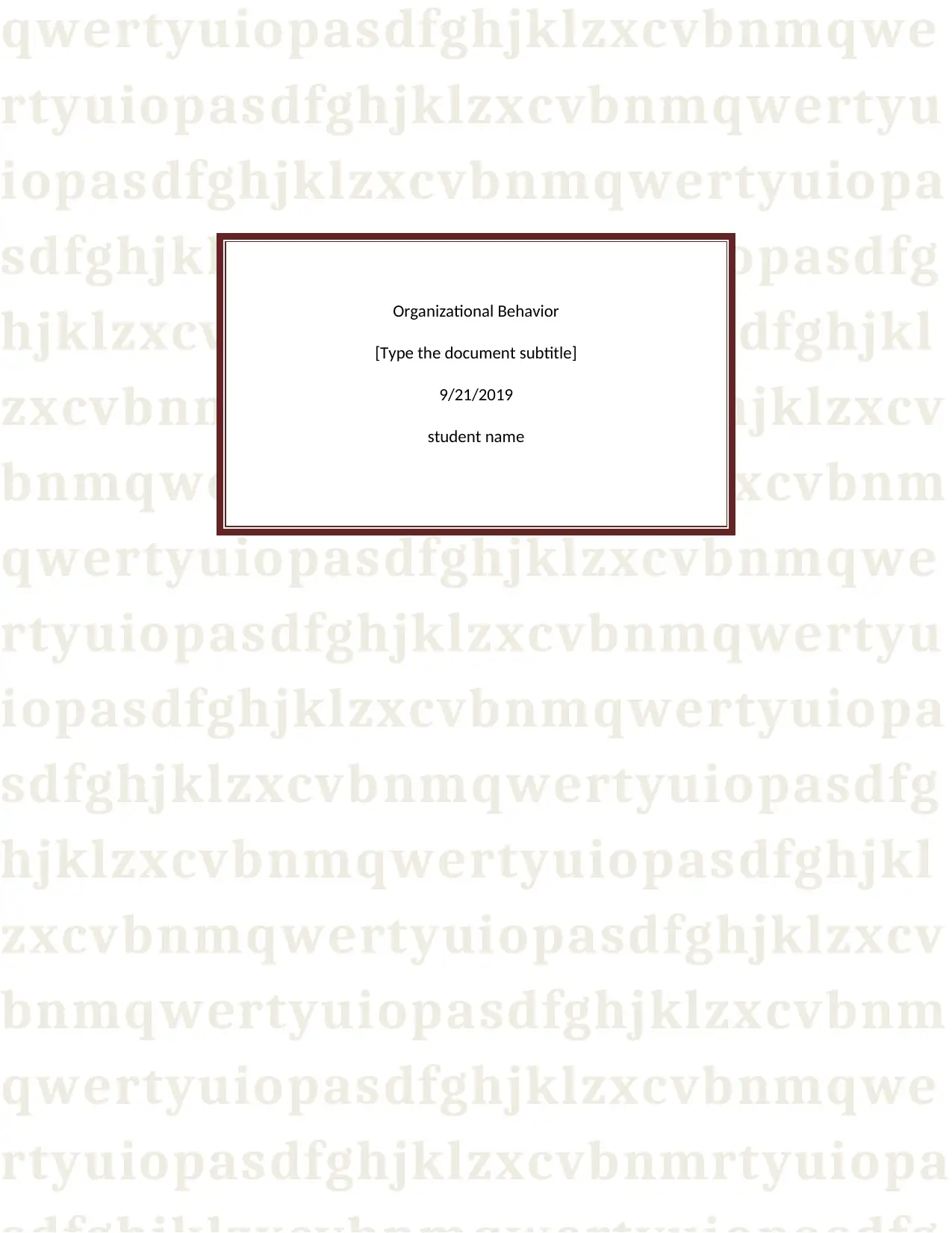
qwertyuiopasdfghjklzxcvbnmqwe
rtyuiopasdfghjklzxcvbnmqwertyu
iopasdfghjklzxcvbnmqwertyuiopa
sdfghjklzxcvbnmqwertyuiopasdfg
hjklzxcvbnmqwertyuiopasdfghjkl
zxcvbnmqwertyuiopasdfghjklzxcv
bnmqwertyuiopasdfghjklzxcvbnm
qwertyuiopasdfghjklzxcvbnmqwe
rtyuiopasdfghjklzxcvbnmqwertyu
iopasdfghjklzxcvbnmqwertyuiopa
sdfghjklzxcvbnmqwertyuiopasdfg
hjklzxcvbnmqwertyuiopasdfghjkl
zxcvbnmqwertyuiopasdfghjklzxcv
bnmqwertyuiopasdfghjklzxcvbnm
qwertyuiopasdfghjklzxcvbnmqwe
rtyuiopasdfghjklzxcvbnmrtyuiopa
Organizational Behavior
[Type the document subtitle]
9/21/2019
student name
rtyuiopasdfghjklzxcvbnmqwertyu
iopasdfghjklzxcvbnmqwertyuiopa
sdfghjklzxcvbnmqwertyuiopasdfg
hjklzxcvbnmqwertyuiopasdfghjkl
zxcvbnmqwertyuiopasdfghjklzxcv
bnmqwertyuiopasdfghjklzxcvbnm
qwertyuiopasdfghjklzxcvbnmqwe
rtyuiopasdfghjklzxcvbnmqwertyu
iopasdfghjklzxcvbnmqwertyuiopa
sdfghjklzxcvbnmqwertyuiopasdfg
hjklzxcvbnmqwertyuiopasdfghjkl
zxcvbnmqwertyuiopasdfghjklzxcv
bnmqwertyuiopasdfghjklzxcvbnm
qwertyuiopasdfghjklzxcvbnmqwe
rtyuiopasdfghjklzxcvbnmrtyuiopa
Organizational Behavior
[Type the document subtitle]
9/21/2019
student name
Paraphrase This Document
Need a fresh take? Get an instant paraphrase of this document with our AI Paraphraser
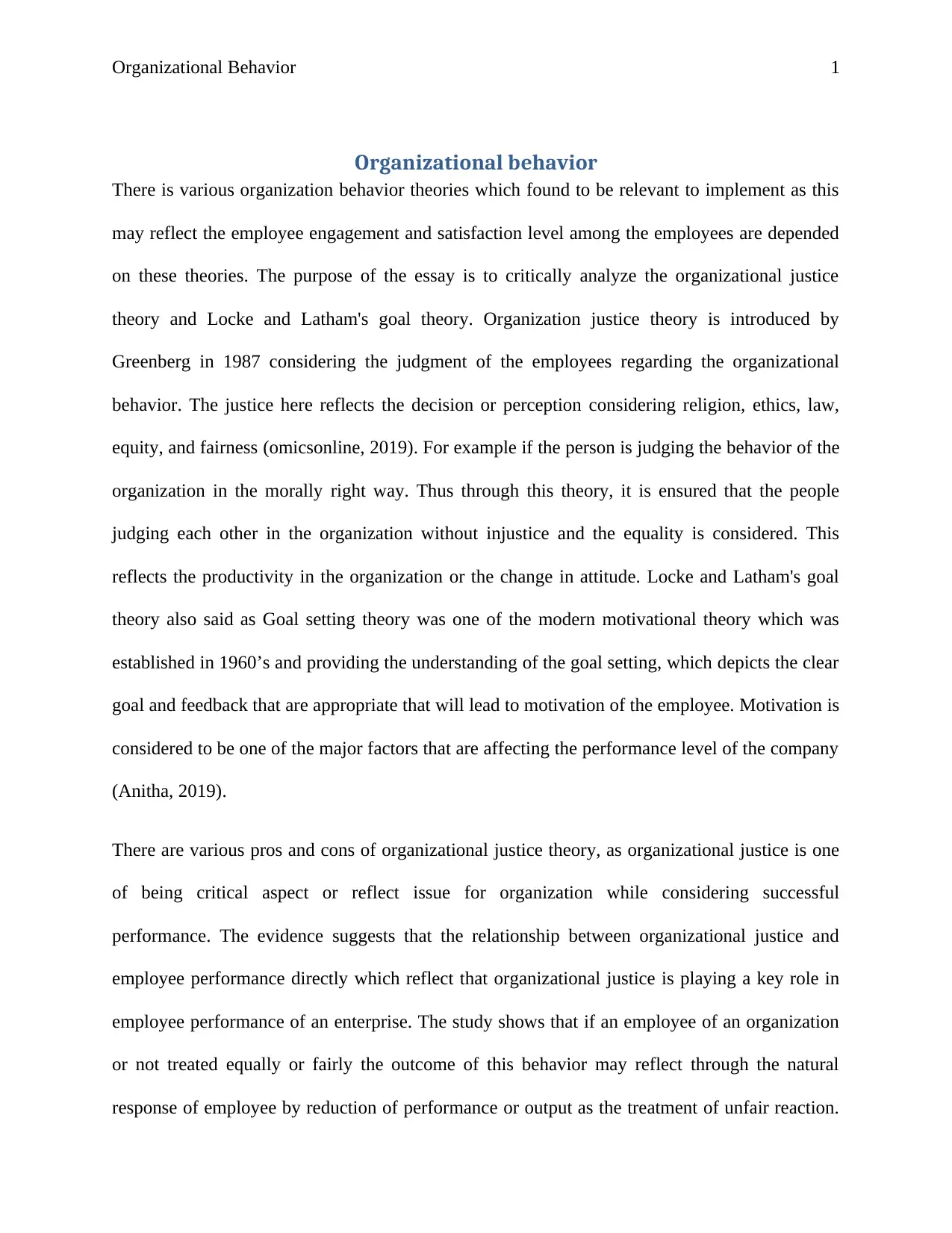
Organizational Behavior 1
Organizational behavior
There is various organization behavior theories which found to be relevant to implement as this
may reflect the employee engagement and satisfaction level among the employees are depended
on these theories. The purpose of the essay is to critically analyze the organizational justice
theory and Locke and Latham's goal theory. Organization justice theory is introduced by
Greenberg in 1987 considering the judgment of the employees regarding the organizational
behavior. The justice here reflects the decision or perception considering religion, ethics, law,
equity, and fairness (omicsonline, 2019). For example if the person is judging the behavior of the
organization in the morally right way. Thus through this theory, it is ensured that the people
judging each other in the organization without injustice and the equality is considered. This
reflects the productivity in the organization or the change in attitude. Locke and Latham's goal
theory also said as Goal setting theory was one of the modern motivational theory which was
established in 1960’s and providing the understanding of the goal setting, which depicts the clear
goal and feedback that are appropriate that will lead to motivation of the employee. Motivation is
considered to be one of the major factors that are affecting the performance level of the company
(Anitha, 2019).
There are various pros and cons of organizational justice theory, as organizational justice is one
of being critical aspect or reflect issue for organization while considering successful
performance. The evidence suggests that the relationship between organizational justice and
employee performance directly which reflect that organizational justice is playing a key role in
employee performance of an enterprise. The study shows that if an employee of an organization
or not treated equally or fairly the outcome of this behavior may reflect through the natural
response of employee by reduction of performance or output as the treatment of unfair reaction.
Organizational behavior
There is various organization behavior theories which found to be relevant to implement as this
may reflect the employee engagement and satisfaction level among the employees are depended
on these theories. The purpose of the essay is to critically analyze the organizational justice
theory and Locke and Latham's goal theory. Organization justice theory is introduced by
Greenberg in 1987 considering the judgment of the employees regarding the organizational
behavior. The justice here reflects the decision or perception considering religion, ethics, law,
equity, and fairness (omicsonline, 2019). For example if the person is judging the behavior of the
organization in the morally right way. Thus through this theory, it is ensured that the people
judging each other in the organization without injustice and the equality is considered. This
reflects the productivity in the organization or the change in attitude. Locke and Latham's goal
theory also said as Goal setting theory was one of the modern motivational theory which was
established in 1960’s and providing the understanding of the goal setting, which depicts the clear
goal and feedback that are appropriate that will lead to motivation of the employee. Motivation is
considered to be one of the major factors that are affecting the performance level of the company
(Anitha, 2019).
There are various pros and cons of organizational justice theory, as organizational justice is one
of being critical aspect or reflect issue for organization while considering successful
performance. The evidence suggests that the relationship between organizational justice and
employee performance directly which reflect that organizational justice is playing a key role in
employee performance of an enterprise. The study shows that if an employee of an organization
or not treated equally or fairly the outcome of this behavior may reflect through the natural
response of employee by reduction of performance or output as the treatment of unfair reaction.
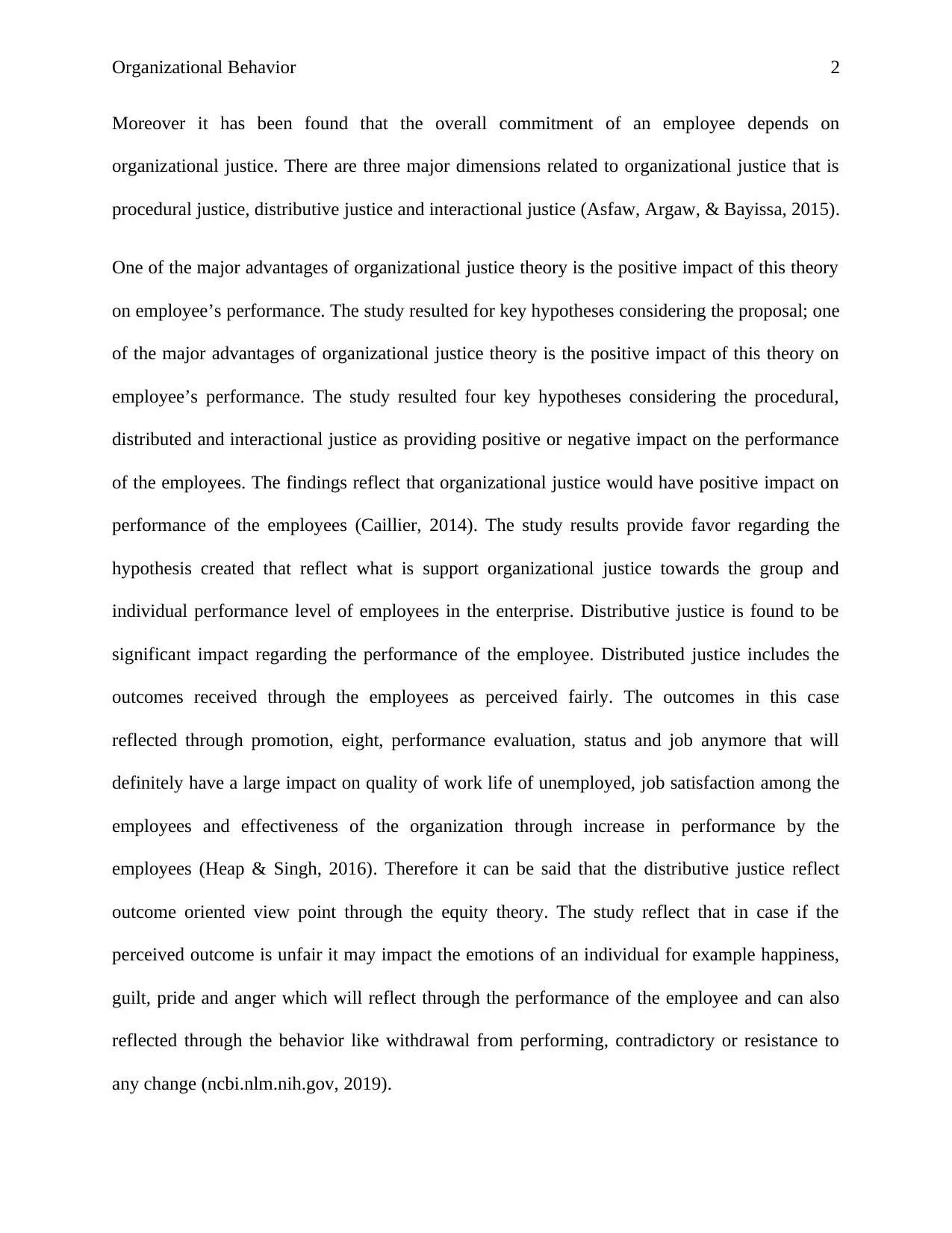
Organizational Behavior 2
Moreover it has been found that the overall commitment of an employee depends on
organizational justice. There are three major dimensions related to organizational justice that is
procedural justice, distributive justice and interactional justice (Asfaw, Argaw, & Bayissa, 2015).
One of the major advantages of organizational justice theory is the positive impact of this theory
on employee’s performance. The study resulted for key hypotheses considering the proposal; one
of the major advantages of organizational justice theory is the positive impact of this theory on
employee’s performance. The study resulted four key hypotheses considering the procedural,
distributed and interactional justice as providing positive or negative impact on the performance
of the employees. The findings reflect that organizational justice would have positive impact on
performance of the employees (Caillier, 2014). The study results provide favor regarding the
hypothesis created that reflect what is support organizational justice towards the group and
individual performance level of employees in the enterprise. Distributive justice is found to be
significant impact regarding the performance of the employee. Distributed justice includes the
outcomes received through the employees as perceived fairly. The outcomes in this case
reflected through promotion, eight, performance evaluation, status and job anymore that will
definitely have a large impact on quality of work life of unemployed, job satisfaction among the
employees and effectiveness of the organization through increase in performance by the
employees (Heap & Singh, 2016). Therefore it can be said that the distributive justice reflect
outcome oriented view point through the equity theory. The study reflect that in case if the
perceived outcome is unfair it may impact the emotions of an individual for example happiness,
guilt, pride and anger which will reflect through the performance of the employee and can also
reflected through the behavior like withdrawal from performing, contradictory or resistance to
any change (ncbi.nlm.nih.gov, 2019).
Moreover it has been found that the overall commitment of an employee depends on
organizational justice. There are three major dimensions related to organizational justice that is
procedural justice, distributive justice and interactional justice (Asfaw, Argaw, & Bayissa, 2015).
One of the major advantages of organizational justice theory is the positive impact of this theory
on employee’s performance. The study resulted for key hypotheses considering the proposal; one
of the major advantages of organizational justice theory is the positive impact of this theory on
employee’s performance. The study resulted four key hypotheses considering the procedural,
distributed and interactional justice as providing positive or negative impact on the performance
of the employees. The findings reflect that organizational justice would have positive impact on
performance of the employees (Caillier, 2014). The study results provide favor regarding the
hypothesis created that reflect what is support organizational justice towards the group and
individual performance level of employees in the enterprise. Distributive justice is found to be
significant impact regarding the performance of the employee. Distributed justice includes the
outcomes received through the employees as perceived fairly. The outcomes in this case
reflected through promotion, eight, performance evaluation, status and job anymore that will
definitely have a large impact on quality of work life of unemployed, job satisfaction among the
employees and effectiveness of the organization through increase in performance by the
employees (Heap & Singh, 2016). Therefore it can be said that the distributive justice reflect
outcome oriented view point through the equity theory. The study reflect that in case if the
perceived outcome is unfair it may impact the emotions of an individual for example happiness,
guilt, pride and anger which will reflect through the performance of the employee and can also
reflected through the behavior like withdrawal from performing, contradictory or resistance to
any change (ncbi.nlm.nih.gov, 2019).
⊘ This is a preview!⊘
Do you want full access?
Subscribe today to unlock all pages.

Trusted by 1+ million students worldwide
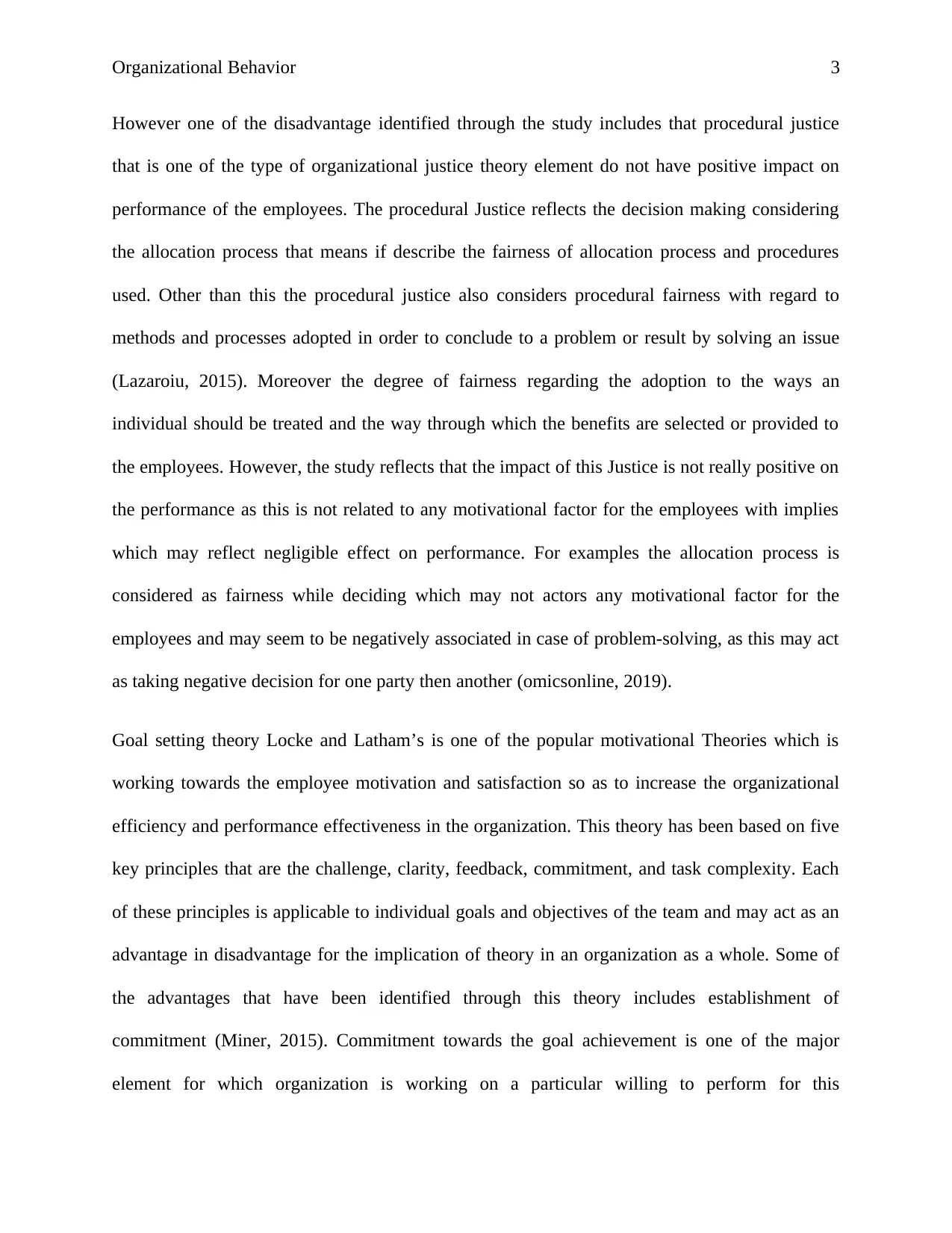
Organizational Behavior 3
However one of the disadvantage identified through the study includes that procedural justice
that is one of the type of organizational justice theory element do not have positive impact on
performance of the employees. The procedural Justice reflects the decision making considering
the allocation process that means if describe the fairness of allocation process and procedures
used. Other than this the procedural justice also considers procedural fairness with regard to
methods and processes adopted in order to conclude to a problem or result by solving an issue
(Lazaroiu, 2015). Moreover the degree of fairness regarding the adoption to the ways an
individual should be treated and the way through which the benefits are selected or provided to
the employees. However, the study reflects that the impact of this Justice is not really positive on
the performance as this is not related to any motivational factor for the employees with implies
which may reflect negligible effect on performance. For examples the allocation process is
considered as fairness while deciding which may not actors any motivational factor for the
employees and may seem to be negatively associated in case of problem-solving, as this may act
as taking negative decision for one party then another (omicsonline, 2019).
Goal setting theory Locke and Latham’s is one of the popular motivational Theories which is
working towards the employee motivation and satisfaction so as to increase the organizational
efficiency and performance effectiveness in the organization. This theory has been based on five
key principles that are the challenge, clarity, feedback, commitment, and task complexity. Each
of these principles is applicable to individual goals and objectives of the team and may act as an
advantage in disadvantage for the implication of theory in an organization as a whole. Some of
the advantages that have been identified through this theory includes establishment of
commitment (Miner, 2015). Commitment towards the goal achievement is one of the major
element for which organization is working on a particular willing to perform for this
However one of the disadvantage identified through the study includes that procedural justice
that is one of the type of organizational justice theory element do not have positive impact on
performance of the employees. The procedural Justice reflects the decision making considering
the allocation process that means if describe the fairness of allocation process and procedures
used. Other than this the procedural justice also considers procedural fairness with regard to
methods and processes adopted in order to conclude to a problem or result by solving an issue
(Lazaroiu, 2015). Moreover the degree of fairness regarding the adoption to the ways an
individual should be treated and the way through which the benefits are selected or provided to
the employees. However, the study reflects that the impact of this Justice is not really positive on
the performance as this is not related to any motivational factor for the employees with implies
which may reflect negligible effect on performance. For examples the allocation process is
considered as fairness while deciding which may not actors any motivational factor for the
employees and may seem to be negatively associated in case of problem-solving, as this may act
as taking negative decision for one party then another (omicsonline, 2019).
Goal setting theory Locke and Latham’s is one of the popular motivational Theories which is
working towards the employee motivation and satisfaction so as to increase the organizational
efficiency and performance effectiveness in the organization. This theory has been based on five
key principles that are the challenge, clarity, feedback, commitment, and task complexity. Each
of these principles is applicable to individual goals and objectives of the team and may act as an
advantage in disadvantage for the implication of theory in an organization as a whole. Some of
the advantages that have been identified through this theory includes establishment of
commitment (Miner, 2015). Commitment towards the goal achievement is one of the major
element for which organization is working on a particular willing to perform for this
Paraphrase This Document
Need a fresh take? Get an instant paraphrase of this document with our AI Paraphraser
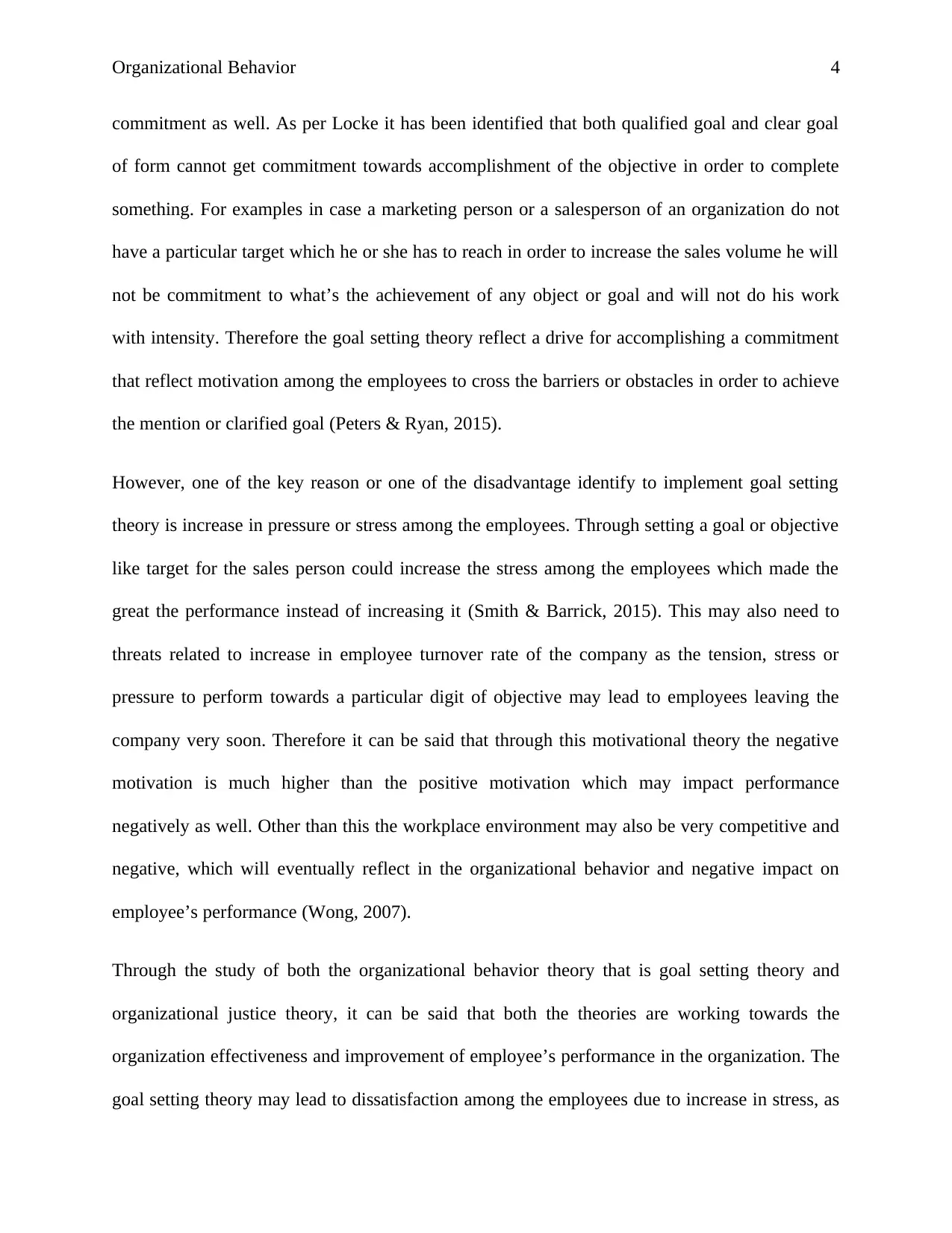
Organizational Behavior 4
commitment as well. As per Locke it has been identified that both qualified goal and clear goal
of form cannot get commitment towards accomplishment of the objective in order to complete
something. For examples in case a marketing person or a salesperson of an organization do not
have a particular target which he or she has to reach in order to increase the sales volume he will
not be commitment to what’s the achievement of any object or goal and will not do his work
with intensity. Therefore the goal setting theory reflect a drive for accomplishing a commitment
that reflect motivation among the employees to cross the barriers or obstacles in order to achieve
the mention or clarified goal (Peters & Ryan, 2015).
However, one of the key reason or one of the disadvantage identify to implement goal setting
theory is increase in pressure or stress among the employees. Through setting a goal or objective
like target for the sales person could increase the stress among the employees which made the
great the performance instead of increasing it (Smith & Barrick, 2015). This may also need to
threats related to increase in employee turnover rate of the company as the tension, stress or
pressure to perform towards a particular digit of objective may lead to employees leaving the
company very soon. Therefore it can be said that through this motivational theory the negative
motivation is much higher than the positive motivation which may impact performance
negatively as well. Other than this the workplace environment may also be very competitive and
negative, which will eventually reflect in the organizational behavior and negative impact on
employee’s performance (Wong, 2007).
Through the study of both the organizational behavior theory that is goal setting theory and
organizational justice theory, it can be said that both the theories are working towards the
organization effectiveness and improvement of employee’s performance in the organization. The
goal setting theory may lead to dissatisfaction among the employees due to increase in stress, as
commitment as well. As per Locke it has been identified that both qualified goal and clear goal
of form cannot get commitment towards accomplishment of the objective in order to complete
something. For examples in case a marketing person or a salesperson of an organization do not
have a particular target which he or she has to reach in order to increase the sales volume he will
not be commitment to what’s the achievement of any object or goal and will not do his work
with intensity. Therefore the goal setting theory reflect a drive for accomplishing a commitment
that reflect motivation among the employees to cross the barriers or obstacles in order to achieve
the mention or clarified goal (Peters & Ryan, 2015).
However, one of the key reason or one of the disadvantage identify to implement goal setting
theory is increase in pressure or stress among the employees. Through setting a goal or objective
like target for the sales person could increase the stress among the employees which made the
great the performance instead of increasing it (Smith & Barrick, 2015). This may also need to
threats related to increase in employee turnover rate of the company as the tension, stress or
pressure to perform towards a particular digit of objective may lead to employees leaving the
company very soon. Therefore it can be said that through this motivational theory the negative
motivation is much higher than the positive motivation which may impact performance
negatively as well. Other than this the workplace environment may also be very competitive and
negative, which will eventually reflect in the organizational behavior and negative impact on
employee’s performance (Wong, 2007).
Through the study of both the organizational behavior theory that is goal setting theory and
organizational justice theory, it can be said that both the theories are working towards the
organization effectiveness and improvement of employee’s performance in the organization. The
goal setting theory may lead to dissatisfaction among the employees due to increase in stress, as
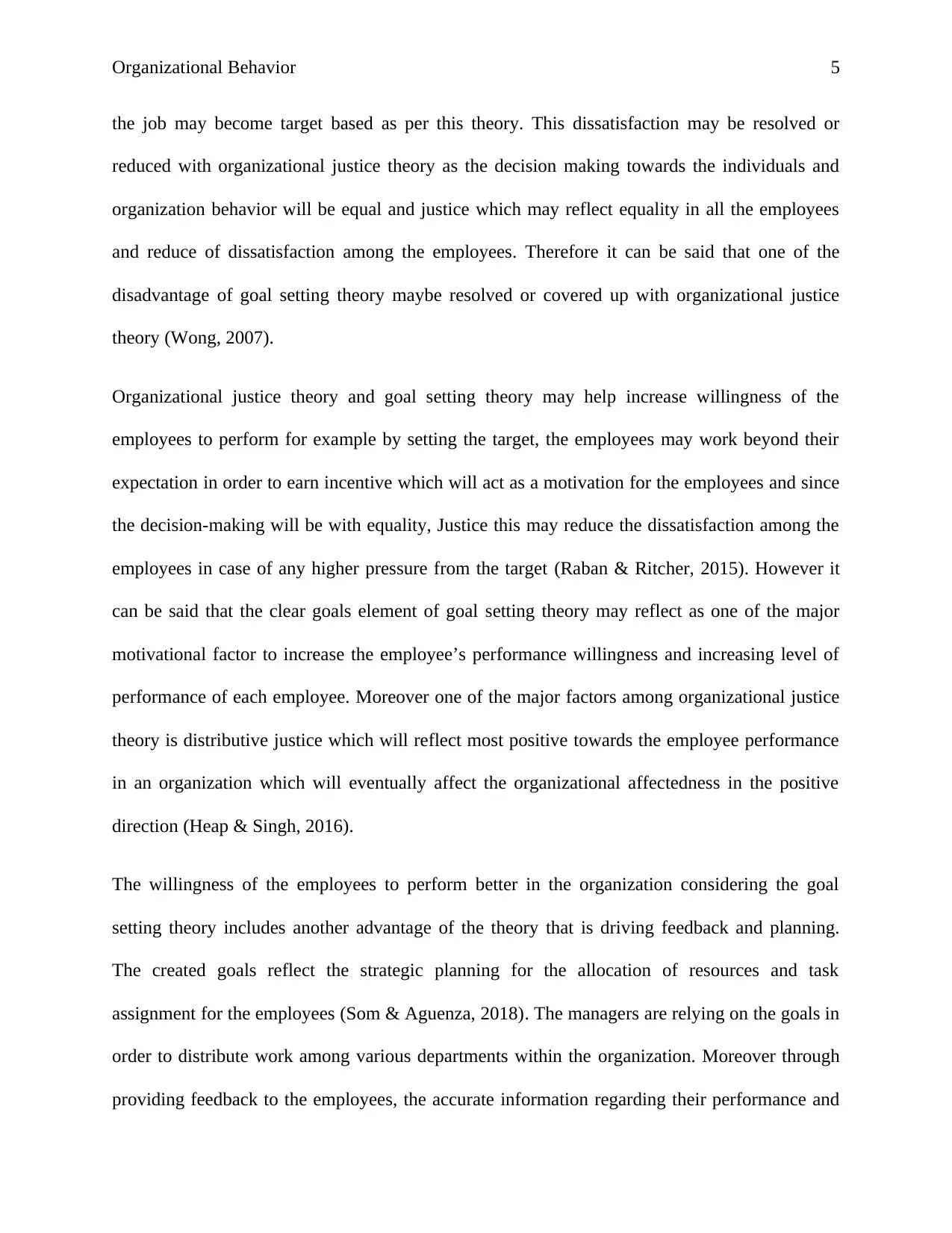
Organizational Behavior 5
the job may become target based as per this theory. This dissatisfaction may be resolved or
reduced with organizational justice theory as the decision making towards the individuals and
organization behavior will be equal and justice which may reflect equality in all the employees
and reduce of dissatisfaction among the employees. Therefore it can be said that one of the
disadvantage of goal setting theory maybe resolved or covered up with organizational justice
theory (Wong, 2007).
Organizational justice theory and goal setting theory may help increase willingness of the
employees to perform for example by setting the target, the employees may work beyond their
expectation in order to earn incentive which will act as a motivation for the employees and since
the decision-making will be with equality, Justice this may reduce the dissatisfaction among the
employees in case of any higher pressure from the target (Raban & Ritcher, 2015). However it
can be said that the clear goals element of goal setting theory may reflect as one of the major
motivational factor to increase the employee’s performance willingness and increasing level of
performance of each employee. Moreover one of the major factors among organizational justice
theory is distributive justice which will reflect most positive towards the employee performance
in an organization which will eventually affect the organizational affectedness in the positive
direction (Heap & Singh, 2016).
The willingness of the employees to perform better in the organization considering the goal
setting theory includes another advantage of the theory that is driving feedback and planning.
The created goals reflect the strategic planning for the allocation of resources and task
assignment for the employees (Som & Aguenza, 2018). The managers are relying on the goals in
order to distribute work among various departments within the organization. Moreover through
providing feedback to the employees, the accurate information regarding their performance and
the job may become target based as per this theory. This dissatisfaction may be resolved or
reduced with organizational justice theory as the decision making towards the individuals and
organization behavior will be equal and justice which may reflect equality in all the employees
and reduce of dissatisfaction among the employees. Therefore it can be said that one of the
disadvantage of goal setting theory maybe resolved or covered up with organizational justice
theory (Wong, 2007).
Organizational justice theory and goal setting theory may help increase willingness of the
employees to perform for example by setting the target, the employees may work beyond their
expectation in order to earn incentive which will act as a motivation for the employees and since
the decision-making will be with equality, Justice this may reduce the dissatisfaction among the
employees in case of any higher pressure from the target (Raban & Ritcher, 2015). However it
can be said that the clear goals element of goal setting theory may reflect as one of the major
motivational factor to increase the employee’s performance willingness and increasing level of
performance of each employee. Moreover one of the major factors among organizational justice
theory is distributive justice which will reflect most positive towards the employee performance
in an organization which will eventually affect the organizational affectedness in the positive
direction (Heap & Singh, 2016).
The willingness of the employees to perform better in the organization considering the goal
setting theory includes another advantage of the theory that is driving feedback and planning.
The created goals reflect the strategic planning for the allocation of resources and task
assignment for the employees (Som & Aguenza, 2018). The managers are relying on the goals in
order to distribute work among various departments within the organization. Moreover through
providing feedback to the employees, the accurate information regarding their performance and
⊘ This is a preview!⊘
Do you want full access?
Subscribe today to unlock all pages.

Trusted by 1+ million students worldwide
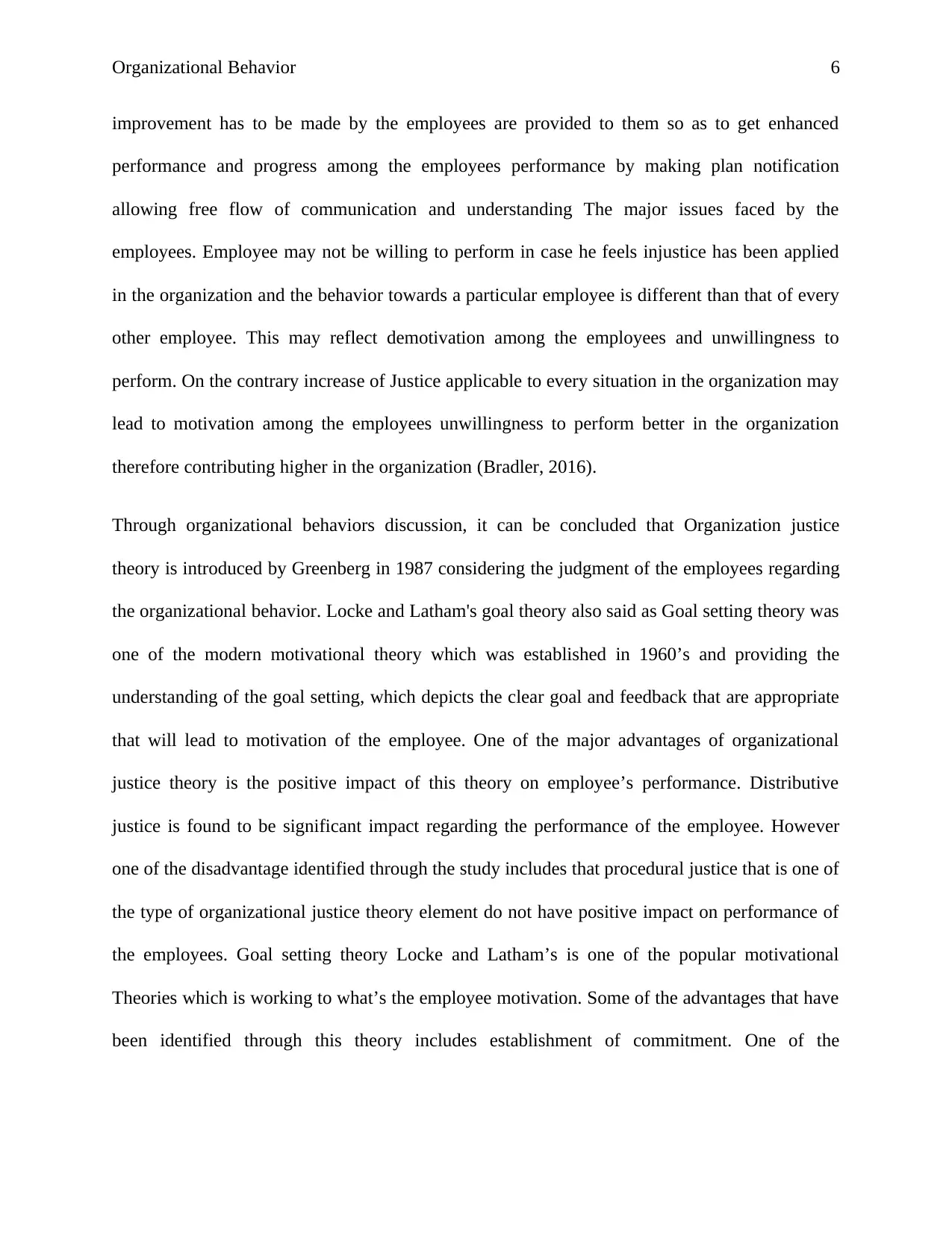
Organizational Behavior 6
improvement has to be made by the employees are provided to them so as to get enhanced
performance and progress among the employees performance by making plan notification
allowing free flow of communication and understanding The major issues faced by the
employees. Employee may not be willing to perform in case he feels injustice has been applied
in the organization and the behavior towards a particular employee is different than that of every
other employee. This may reflect demotivation among the employees and unwillingness to
perform. On the contrary increase of Justice applicable to every situation in the organization may
lead to motivation among the employees unwillingness to perform better in the organization
therefore contributing higher in the organization (Bradler, 2016).
Through organizational behaviors discussion, it can be concluded that Organization justice
theory is introduced by Greenberg in 1987 considering the judgment of the employees regarding
the organizational behavior. Locke and Latham's goal theory also said as Goal setting theory was
one of the modern motivational theory which was established in 1960’s and providing the
understanding of the goal setting, which depicts the clear goal and feedback that are appropriate
that will lead to motivation of the employee. One of the major advantages of organizational
justice theory is the positive impact of this theory on employee’s performance. Distributive
justice is found to be significant impact regarding the performance of the employee. However
one of the disadvantage identified through the study includes that procedural justice that is one of
the type of organizational justice theory element do not have positive impact on performance of
the employees. Goal setting theory Locke and Latham’s is one of the popular motivational
Theories which is working to what’s the employee motivation. Some of the advantages that have
been identified through this theory includes establishment of commitment. One of the
improvement has to be made by the employees are provided to them so as to get enhanced
performance and progress among the employees performance by making plan notification
allowing free flow of communication and understanding The major issues faced by the
employees. Employee may not be willing to perform in case he feels injustice has been applied
in the organization and the behavior towards a particular employee is different than that of every
other employee. This may reflect demotivation among the employees and unwillingness to
perform. On the contrary increase of Justice applicable to every situation in the organization may
lead to motivation among the employees unwillingness to perform better in the organization
therefore contributing higher in the organization (Bradler, 2016).
Through organizational behaviors discussion, it can be concluded that Organization justice
theory is introduced by Greenberg in 1987 considering the judgment of the employees regarding
the organizational behavior. Locke and Latham's goal theory also said as Goal setting theory was
one of the modern motivational theory which was established in 1960’s and providing the
understanding of the goal setting, which depicts the clear goal and feedback that are appropriate
that will lead to motivation of the employee. One of the major advantages of organizational
justice theory is the positive impact of this theory on employee’s performance. Distributive
justice is found to be significant impact regarding the performance of the employee. However
one of the disadvantage identified through the study includes that procedural justice that is one of
the type of organizational justice theory element do not have positive impact on performance of
the employees. Goal setting theory Locke and Latham’s is one of the popular motivational
Theories which is working to what’s the employee motivation. Some of the advantages that have
been identified through this theory includes establishment of commitment. One of the
Paraphrase This Document
Need a fresh take? Get an instant paraphrase of this document with our AI Paraphraser
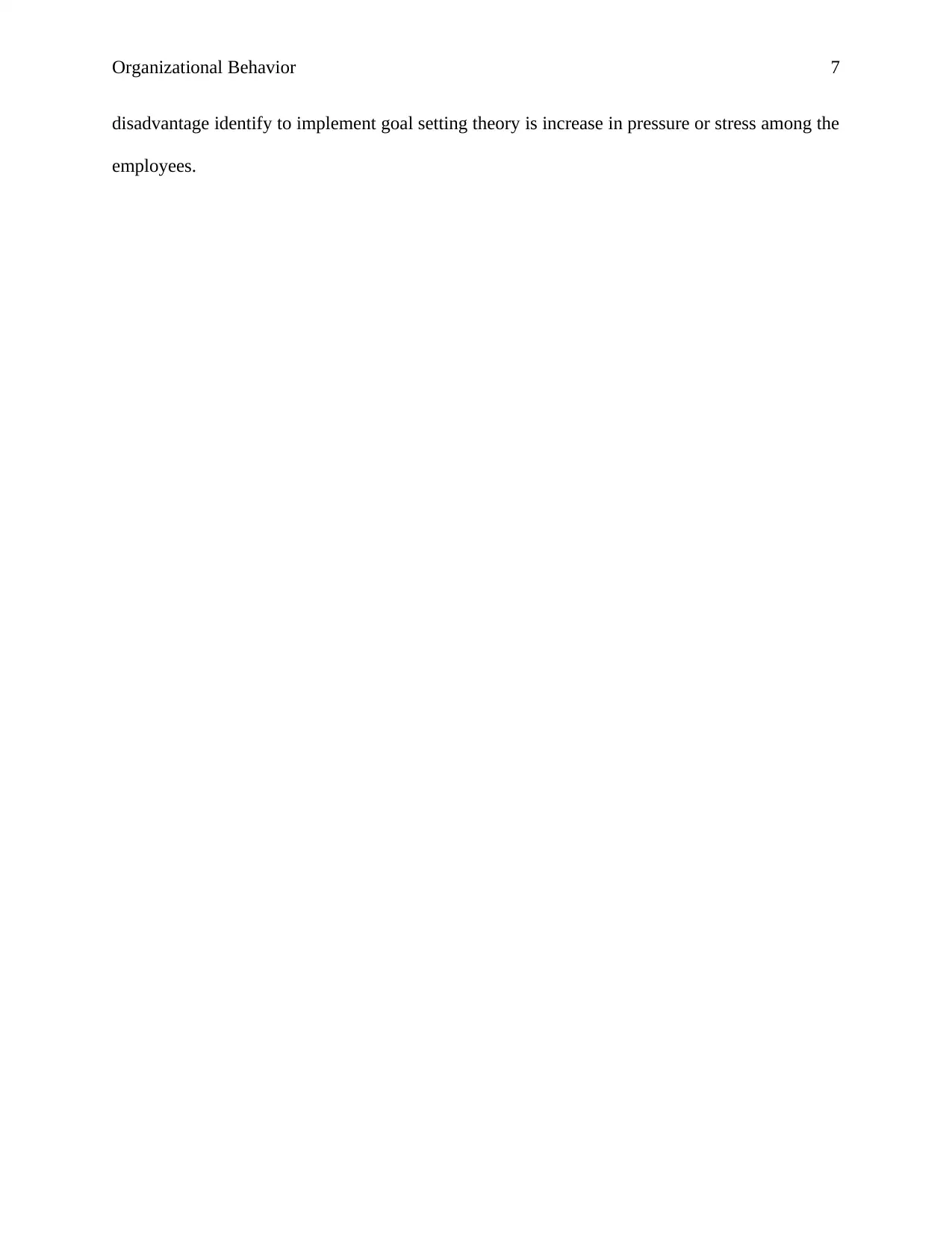
Organizational Behavior 7
disadvantage identify to implement goal setting theory is increase in pressure or stress among the
employees.
disadvantage identify to implement goal setting theory is increase in pressure or stress among the
employees.
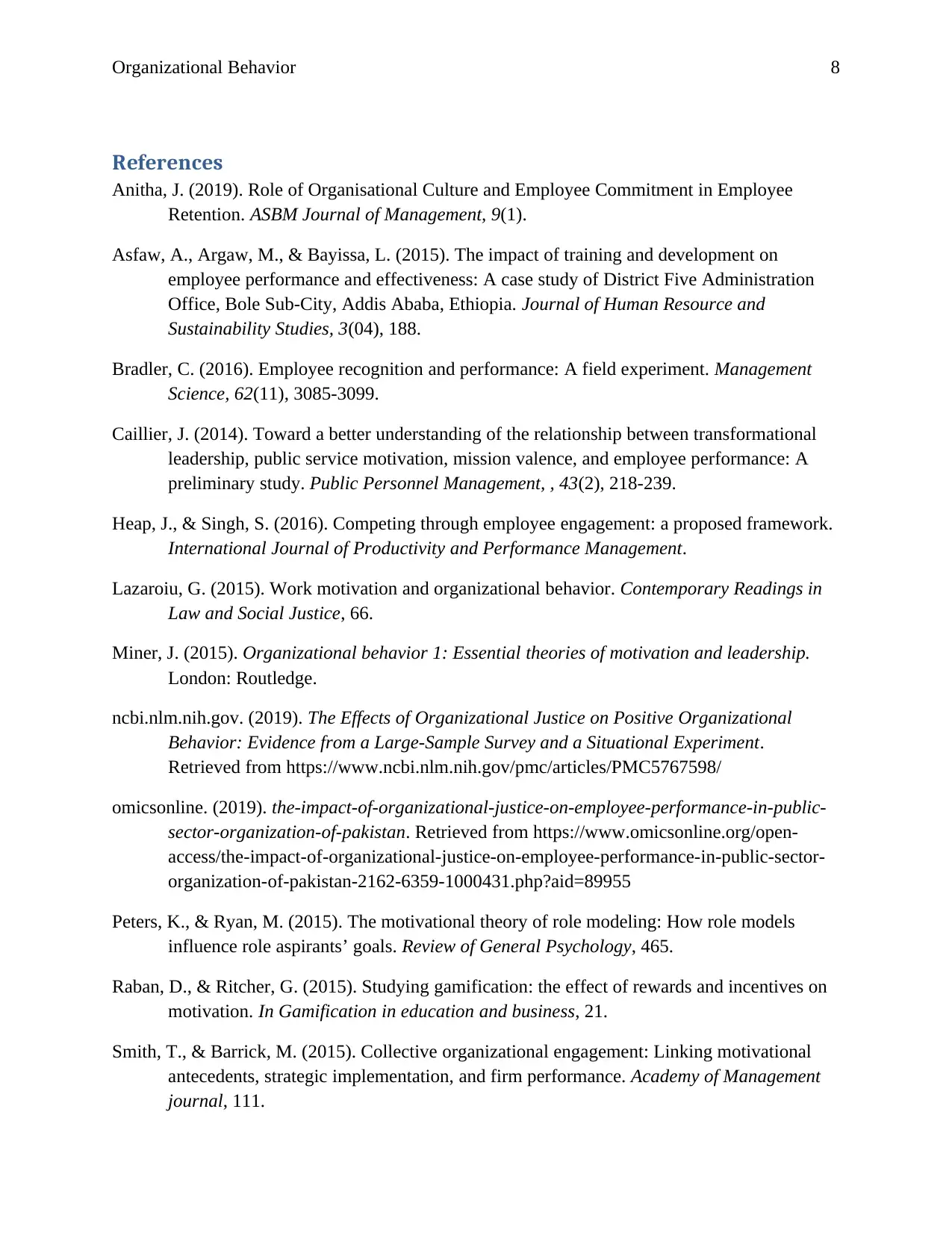
Organizational Behavior 8
References
Anitha, J. (2019). Role of Organisational Culture and Employee Commitment in Employee
Retention. ASBM Journal of Management, 9(1).
Asfaw, A., Argaw, M., & Bayissa, L. (2015). The impact of training and development on
employee performance and effectiveness: A case study of District Five Administration
Office, Bole Sub-City, Addis Ababa, Ethiopia. Journal of Human Resource and
Sustainability Studies, 3(04), 188.
Bradler, C. (2016). Employee recognition and performance: A field experiment. Management
Science, 62(11), 3085-3099.
Caillier, J. (2014). Toward a better understanding of the relationship between transformational
leadership, public service motivation, mission valence, and employee performance: A
preliminary study. Public Personnel Management, , 43(2), 218-239.
Heap, J., & Singh, S. (2016). Competing through employee engagement: a proposed framework.
International Journal of Productivity and Performance Management.
Lazaroiu, G. (2015). Work motivation and organizational behavior. Contemporary Readings in
Law and Social Justice, 66.
Miner, J. (2015). Organizational behavior 1: Essential theories of motivation and leadership.
London: Routledge.
ncbi.nlm.nih.gov. (2019). The Effects of Organizational Justice on Positive Organizational
Behavior: Evidence from a Large-Sample Survey and a Situational Experiment.
Retrieved from https://www.ncbi.nlm.nih.gov/pmc/articles/PMC5767598/
omicsonline. (2019). the-impact-of-organizational-justice-on-employee-performance-in-public-
sector-organization-of-pakistan. Retrieved from https://www.omicsonline.org/open-
access/the-impact-of-organizational-justice-on-employee-performance-in-public-sector-
organization-of-pakistan-2162-6359-1000431.php?aid=89955
Peters, K., & Ryan, M. (2015). The motivational theory of role modeling: How role models
influence role aspirants’ goals. Review of General Psychology, 465.
Raban, D., & Ritcher, G. (2015). Studying gamification: the effect of rewards and incentives on
motivation. In Gamification in education and business, 21.
Smith, T., & Barrick, M. (2015). Collective organizational engagement: Linking motivational
antecedents, strategic implementation, and firm performance. Academy of Management
journal, 111.
References
Anitha, J. (2019). Role of Organisational Culture and Employee Commitment in Employee
Retention. ASBM Journal of Management, 9(1).
Asfaw, A., Argaw, M., & Bayissa, L. (2015). The impact of training and development on
employee performance and effectiveness: A case study of District Five Administration
Office, Bole Sub-City, Addis Ababa, Ethiopia. Journal of Human Resource and
Sustainability Studies, 3(04), 188.
Bradler, C. (2016). Employee recognition and performance: A field experiment. Management
Science, 62(11), 3085-3099.
Caillier, J. (2014). Toward a better understanding of the relationship between transformational
leadership, public service motivation, mission valence, and employee performance: A
preliminary study. Public Personnel Management, , 43(2), 218-239.
Heap, J., & Singh, S. (2016). Competing through employee engagement: a proposed framework.
International Journal of Productivity and Performance Management.
Lazaroiu, G. (2015). Work motivation and organizational behavior. Contemporary Readings in
Law and Social Justice, 66.
Miner, J. (2015). Organizational behavior 1: Essential theories of motivation and leadership.
London: Routledge.
ncbi.nlm.nih.gov. (2019). The Effects of Organizational Justice on Positive Organizational
Behavior: Evidence from a Large-Sample Survey and a Situational Experiment.
Retrieved from https://www.ncbi.nlm.nih.gov/pmc/articles/PMC5767598/
omicsonline. (2019). the-impact-of-organizational-justice-on-employee-performance-in-public-
sector-organization-of-pakistan. Retrieved from https://www.omicsonline.org/open-
access/the-impact-of-organizational-justice-on-employee-performance-in-public-sector-
organization-of-pakistan-2162-6359-1000431.php?aid=89955
Peters, K., & Ryan, M. (2015). The motivational theory of role modeling: How role models
influence role aspirants’ goals. Review of General Psychology, 465.
Raban, D., & Ritcher, G. (2015). Studying gamification: the effect of rewards and incentives on
motivation. In Gamification in education and business, 21.
Smith, T., & Barrick, M. (2015). Collective organizational engagement: Linking motivational
antecedents, strategic implementation, and firm performance. Academy of Management
journal, 111.
⊘ This is a preview!⊘
Do you want full access?
Subscribe today to unlock all pages.

Trusted by 1+ million students worldwide
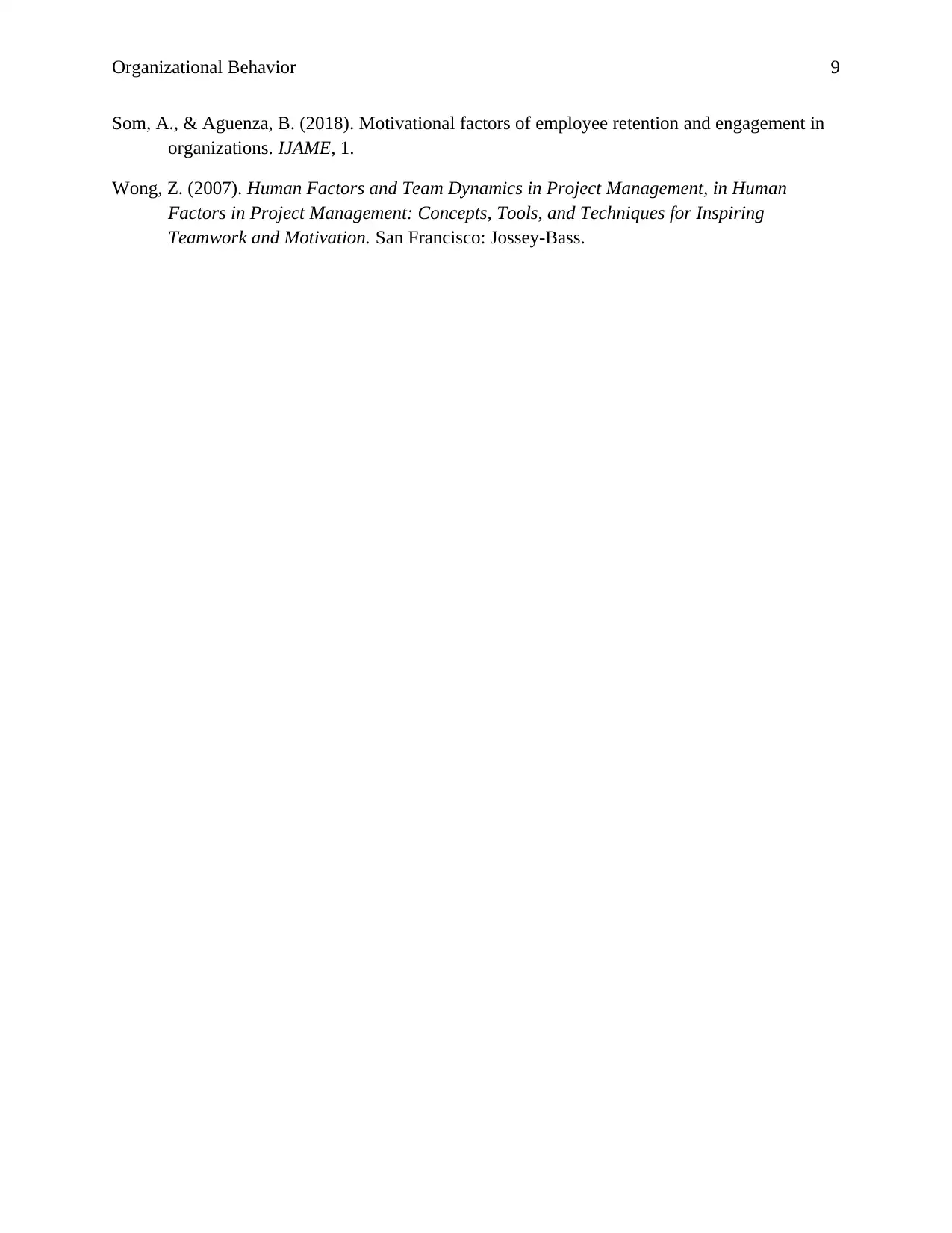
Organizational Behavior 9
Som, A., & Aguenza, B. (2018). Motivational factors of employee retention and engagement in
organizations. IJAME, 1.
Wong, Z. (2007). Human Factors and Team Dynamics in Project Management, in Human
Factors in Project Management: Concepts, Tools, and Techniques for Inspiring
Teamwork and Motivation. San Francisco: Jossey-Bass.
Som, A., & Aguenza, B. (2018). Motivational factors of employee retention and engagement in
organizations. IJAME, 1.
Wong, Z. (2007). Human Factors and Team Dynamics in Project Management, in Human
Factors in Project Management: Concepts, Tools, and Techniques for Inspiring
Teamwork and Motivation. San Francisco: Jossey-Bass.
1 out of 10
Related Documents
Your All-in-One AI-Powered Toolkit for Academic Success.
+13062052269
info@desklib.com
Available 24*7 on WhatsApp / Email
![[object Object]](/_next/static/media/star-bottom.7253800d.svg)
Unlock your academic potential
Copyright © 2020–2025 A2Z Services. All Rights Reserved. Developed and managed by ZUCOL.




